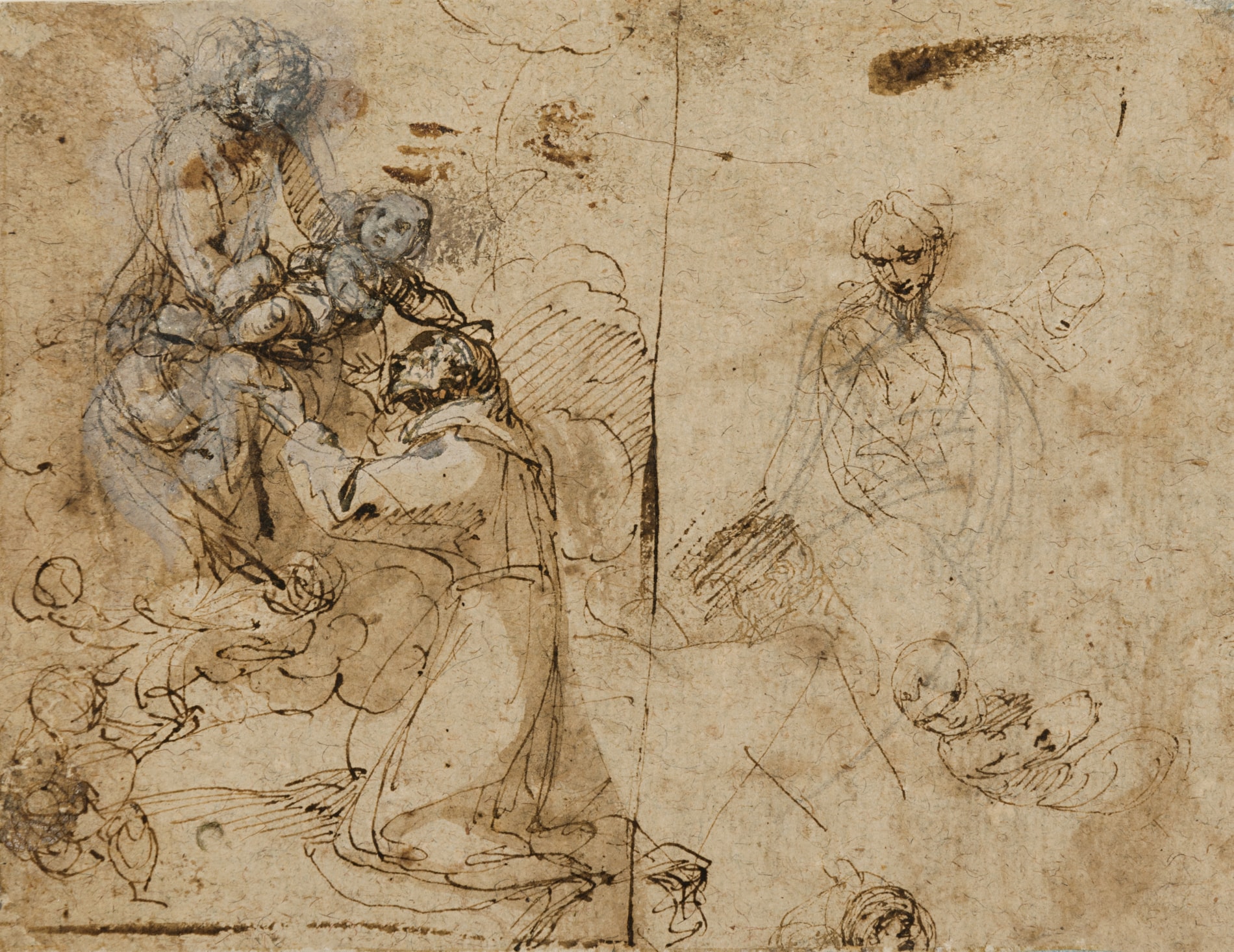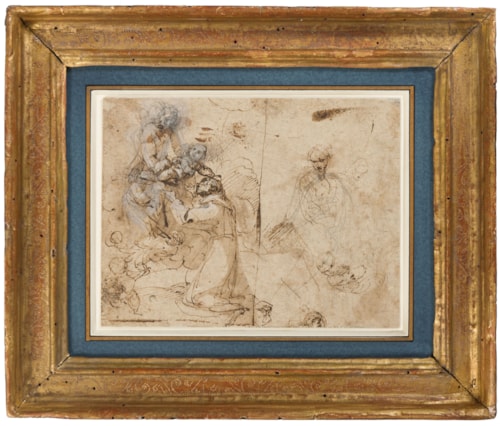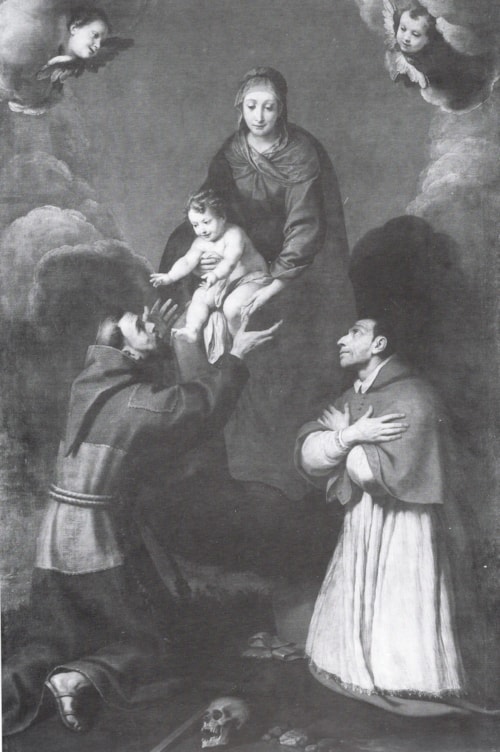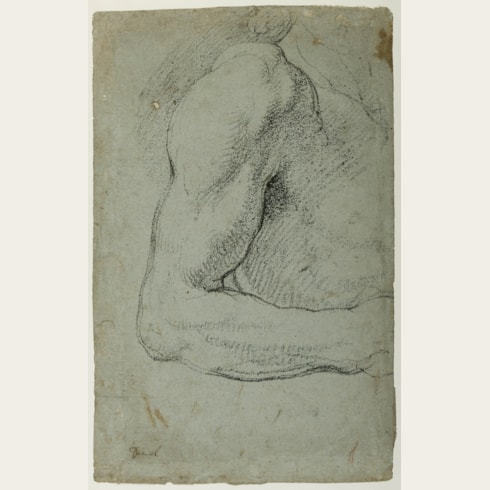Daniele CRESPI
(Busto Arsizio c.1598 - Milan 1630)
Studies of the Virgin and Child with a Kneeling Monk
Sold
Pen and brown ink and brown wash, heightened with white, over a partial underdrawing in black chalk, on buff paper.
Laid down.
Inscribed annibale Caracci on the backing sheet.
140 x 184 mm. (5 1/2 x 7 1/4 in.)
Laid down.
Inscribed annibale Caracci on the backing sheet.
140 x 184 mm. (5 1/2 x 7 1/4 in.)
The composition of this draiwng is related, albeit in reverse, to that of a large, late painting of The Virgin with Saints Francis and Charles Borromeo by Daniele Crespi, in the Pinacoteca Ambrosiana in Milan. The Ambrosiana canvas, which is signed but undated, is thought to have been completed around 1628, at about the same time that Crespi was working on the fresco cycle for the Certosa di Garegnano. A somewhat earlier variant of the Ambrosiana composition, with several differences, is found in an altarpiece, variously attributed to Crespi himself or his studio, in the church of San Biagio in the Lombard town of Codogno.
A compositional pen and ink study by Crespi for the Ambrosiana painting is in the collection of the Kunsthalle in Bremen, while another related drawing, which is somewhat closer to the Codogno altarpiece than the painting in the Ambrosiana, is in the Szépmüvészeti Múzeum in Budapest.
The vigorous draughtsmanship of the present sheet, rapidly drawn in pen and ink, is a feature of many of Crespi’s preparatory studies for paintings. The nervous energy of the drawing is, however, tempered in the composition of the final painting in the Ambrosiana; as Nancy Ward Nielsen has pointed out, ‘This change from drawing to painting, from Lombard technique and emotion to the calm and considered final work is typical of Daniele.’ Among stylistically comparable drawings by Crespi is a study of a figure kneeling in adoration, in the Biblioteca Ambrosiana in Milan, and a compositional study, also in the Ambrosiana collection, for a lunette fresco of The Resurrection of Raymond Diocrès of 1629 in the Certosa di Garegnano.
A compositional pen and ink study by Crespi for the Ambrosiana painting is in the collection of the Kunsthalle in Bremen, while another related drawing, which is somewhat closer to the Codogno altarpiece than the painting in the Ambrosiana, is in the Szépmüvészeti Múzeum in Budapest.
The vigorous draughtsmanship of the present sheet, rapidly drawn in pen and ink, is a feature of many of Crespi’s preparatory studies for paintings. The nervous energy of the drawing is, however, tempered in the composition of the final painting in the Ambrosiana; as Nancy Ward Nielsen has pointed out, ‘This change from drawing to painting, from Lombard technique and emotion to the calm and considered final work is typical of Daniele.’ Among stylistically comparable drawings by Crespi is a study of a figure kneeling in adoration, in the Biblioteca Ambrosiana in Milan, and a compositional study, also in the Ambrosiana collection, for a lunette fresco of The Resurrection of Raymond Diocrès of 1629 in the Certosa di Garegnano.
Although he enjoyed only a relatively brief career of around ten or eleven years, Daniele Crespi was among the most significant painters working in Milan in the first quarter of the 17th century. Although nothing is known of his early training, he was certainly a precocious artist, for by 1619 he was assisting the painter Guglielmo Caccia, known as Moncalvo, on the frescoes of the dome and pendentives of the church of San Vittore al Corpo in Milan. Among Crespi’s earliest documented independent works is the fresco decoration of a chapel in the Milanese church of Sant’ Eustorgio, completed in 1621, and an Adoration of the Magi in Sant’ Alessandro of around the same date. This was followed a few years later by work in the church of San Protaso ad Monachos in Milan, while between 1623 and 1627 he painted several works for Santa Maria di Campagna in Piacenza, and also decorated the organ shutters in the Milanese church of Santa Maria della Passione. An altarpiece of The Martyrdom of Saint Mark for the church of San Marco in Novara was completed in 1626. There followed commissions from two of the most important Carthusian monasteries in Lombardy which represent the culmination of Crespi’s activity as a fresco painter. An extensive series of frescoes for the nave, entrance hall and ceiling of the Certosa of Garegnano, in the outskirts of Milan, depicting scenes from the early history of the Carthusian order and its founder Saint Bruno of Cologne and completed in 1629, are regarded as among the artist’s finest works. A larger and equally impressive cycle of frescoes for the Certosa in Pavia, begun in 1629, was left unfinished at Crespi’s death from the plague the following year, at the age of about thirty-two.
As a painter and draughtsman, Crespi’s work combines both Lombard and Emilian influences. As Rudolf Wittkower has written of the artist, ‘In his best works Daniele combined severe realism and parsimonious handling of pictorial means with a sincerity of expression fully in sympathy with the religious climate at Milan.’ Similarly, another modern scholar has noted that ‘Crespi was a true artist: learned, original, richly diverse and devoted to his art, well able to establish his artistic standpoint amid the cultural and religious preoccupations of his time. He was also a perfectionist in technique and execution…the young Crespi early distanced himself from the Milanese academy in order to seek out new directions: mastering the rules of composition and accuracy of drawing and the absorption of ‘academic tradition’ were only foundations, to which he added a marvellous attention to form and a sincere and versatile pursuit of the ‘natural’.’
Although Daniele Crespi was among the most gifted draughtsmen working in Milan in the 1620s, only about seventy drawings by him are known. Almost all of these appear to be preparatory studies for paintings or frescoes, and no independent, finished drawings by the artist have survived.
As a painter and draughtsman, Crespi’s work combines both Lombard and Emilian influences. As Rudolf Wittkower has written of the artist, ‘In his best works Daniele combined severe realism and parsimonious handling of pictorial means with a sincerity of expression fully in sympathy with the religious climate at Milan.’ Similarly, another modern scholar has noted that ‘Crespi was a true artist: learned, original, richly diverse and devoted to his art, well able to establish his artistic standpoint amid the cultural and religious preoccupations of his time. He was also a perfectionist in technique and execution…the young Crespi early distanced himself from the Milanese academy in order to seek out new directions: mastering the rules of composition and accuracy of drawing and the absorption of ‘academic tradition’ were only foundations, to which he added a marvellous attention to form and a sincere and versatile pursuit of the ‘natural’.’
Although Daniele Crespi was among the most gifted draughtsmen working in Milan in the 1620s, only about seventy drawings by him are known. Almost all of these appear to be preparatory studies for paintings or frescoes, and no independent, finished drawings by the artist have survived.
Provenance
The Principe Castelbarco, Milan
Hans Calmann, London (as attributed to Federico Barocci)
Purchased from him in 1958 by Robert Landolt, Chur
Thence by descent.
Hans Calmann, London (as attributed to Federico Barocci)
Purchased from him in 1958 by Robert Landolt, Chur
Thence by descent.
Literature
Michael Matile, Zwiegespräch mit Zeichnungen: Werke des 15. bis 18. Jahrhunderts aus der Sammlung Robert Landolt, exhibition catalogue, Zurich, 2013-2014, pp.84-85, no.34.
Exhibition
Zurich, Graphische Sammlung ETH, Zwiegespräch mit Zeichnungen: Werke des 15. bis 18. Jahrhunderts aus der Sammlung Robert Landolt, 2013-2014, no.34.







